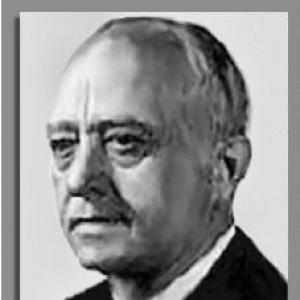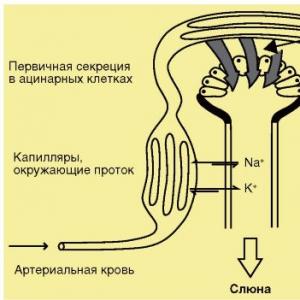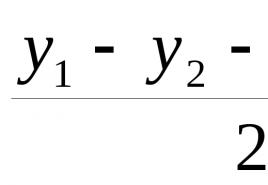In chemical reactions, carbon is. Carbon chemical properties
Element characteristic
6 С 1s 2 2s 2 2p 2
Isotopes: 12 C (98.892%); 13 C (1.108%); 14 C (radioactive)
Clarke in the earth's crust is 0.48% by mass. Forms of finding:
in free form (coal, diamonds);
in the composition of carbonates (CaCO 3, MgCO 3, etc.);
as part of combustible minerals (coal, oil, gas);
in the form of CO 2 - in the atmosphere (0.03% by volume);
in the World Ocean - in the form of НСO 3 - anions;
as part of living matter (-18% carbon).
Carbon chemistry is basically organic chemistry. In the course of inorganic chemistry, the following C-containing substances are studied: free carbon, oxides (CO and CO 2), carbonic acid, carbonates and bicarbonates.
Free carbon. Allotropy.
In a free state, carbon forms 3 allotropic modifications: diamond, graphite and artificially produced carbyne. These modifications of carbon differ in crystal chemical structure and physical characteristics.
Diamond
In a diamond crystal, each carbon atom is tightly covalently bonded to four others, located around it at equal distances.
All carbon atoms are in the sp 3 -hybridization state. The atomic crystal lattice of diamond has a tetrahedral structure.
Diamond is a colorless, transparent substance that strongly refracts light. It has the highest hardness among all known substances. Diamond is fragile, refractory, poorly conducts heat and electric current. Small distances between adjacent carbon atoms (0.154 nm) result in a rather high density of diamond (3.5 g / cm 3).
Graphite
In the crystal lattice of graphite, each carbon atom is in the state of sp 2 -hybridization and forms three strong covalent bonds with carbon atoms located in the same layer. Three electrons of each atom, carbon, participate in the formation of these bonds, and the fourth valence electrons form n-bonds and are relatively free (mobile). They determine the electrical and thermal conductivity of graphite.
The length of the covalent bond between adjacent carbon atoms in the same plane is 0.152 nm, and the distance between the C atoms in different layers is 2.5 times greater, so the bonds between them are weak.

Graphite is an opaque, soft, greasy to the touch substance of gray-black color with a metallic luster; conducts heat and electric current well. Graphite has a lower density compared to diamond and is easily split into thin flakes.
The disordered structure of fine-crystalline graphite underlies the structure of various forms of amorphous carbon, the most important of which are coke, brown and bituminous coals, soot, activated (active) carbon.
Carbin
This allotropic modification of carbon is obtained by catalytic oxidation (dehydropolycondensation) of acetylene. Carbyne is a chain polymer that has two forms:
C \u003d C-C \u003d C -... and ... \u003d C \u003d C \u003d C \u003d
Carbyne has semiconducting properties.
Chemical properties of carbon
At ordinary temperatures, both carbon modifications (diamond and graphite) are chemically inert. Fine-crystalline forms of graphite - coke, soot, activated carbon - are more reactive, but, as a rule, after they have been preheated to a high temperature.
C - active reducing agent:
1. Interaction with oxygen
C + O 2 \u003d CO 2 + 393.5 kJ (in excess of O 2)
2C + O 2 \u003d 2CO + 221 kJ (with a lack of O 2)
Burning coal is one of the most important sources of energy.
2. Interaction with fluorine and sulfur.
C + 2F 2 \u003d CF 4 carbon tetrafluoride
C + 2S \u003d CS 2 carbon disulfide
3. Coke is one of the most important reducing agents used in industry. In metallurgy, it is used to produce metals from oxides, for example:
ЗС + Fe 2 O 3 \u003d 2Fe + ЗСО
C + ZnO \u003d Zn + CO
4. When carbon interacts with oxides of alkali and alkaline earth metals, the reduced metal combines with carbon to form carbide. For example: ЗС + СаО \u003d СаС 2 + СО calcium carbide
5. Coke is also used to obtain silicon:
2С + SiO 2 \u003d Si + 2СО
6. With an excess of coke, silicon carbide (carborundum) SiC is formed.
Obtaining "water gas" (gasification of solid fuel)
Passing water vapor through hot coal produces a combustible mixture of CO and H 2, called water gas:
C + H 2 O \u003d CO + H 2
7. Reactions with oxidizing acids.
Activated or charcoal, when heated, reduces the anions NO 3 - and SO 4 2- from concentrated acids:
C + 4HNO 3 \u003d CO 2 + 4NO 2 + 2H 2 O
C + 2H 2 SO 4 \u003d CO 2 + 2SO 2 + 2H 2 O
8. Reactions with molten alkali metal nitrates
In KNO 3 and NaNO 3 melts, crushed coal burns intensely with the formation of a blinding flame:
5C + 4KNO 3 \u003d 2K 2 CO 3 + ZCO 2 + 2N 2
C - low-activity oxidizing agent:
1. Formation of salt-like carbides with active metals.
A significant weakening of the non-metallic properties of carbon is expressed in the fact that its functions as an oxidizing agent are manifested to a much lesser extent than its reduction functions.
2. Only in reactions with active metals, carbon atoms pass into negatively charged ions C -4 and (C \u003d C) 2-, forming salt-like carbides:
ЗС + 4Al \u003d Аl 4 С 3 aluminum carbide
2C + Ca \u003d CaC 2 calcium carbide
3. Carbides of the ionic type are very unstable compounds, they easily decompose under the action of acids and water, which indicates the instability of negatively charged carbon anions:
Al 4 C 3 + 12H 2 O \u003d 3CH 4 + 4Al (OH) 3
CaC 2 + 2H 2 O \u003d C 2 H 2 + Ca (OH) 2
4. Formation of covalent compounds with metals
In melts of mixtures of carbon with transition metals, carbides are formed predominantly with a covalent type of bond. Their molecules have a variable composition, and the substances in general are close to alloys. Such carbides are highly resistant, they are chemically inert towards water, acids, alkalis and many other reagents.
5. Interaction with hydrogen
At high T and P, in the presence of a nickel catalyst, carbon combines with hydrogen:
С + 2НН 2 → СНН 4
The reaction is very reversible and not practical.
Free carbon is a typical reducing agent. When oxidized with oxygen in excess air, it turns into carbon monoxide (IV):
with a lack of - into carbon monoxide (II):
Both reactions are highly exothermic.
When carbon is heated in an atmosphere of carbon monoxide (IV), carbon monoxide is formed:
Carbon reduces many metals from their oxides:
This is how reactions proceed with oxides of cadmium, copper, lead. When carbon interacts with oxides of alkaline earth metals, aluminum and some other metals, carbides are formed:

This is explained by the fact that active metals are stronger reducing agents than carbon, therefore, when heated, the resulting metals are oxidized with an excess of carbon:

Carbon monoxide (II).
Incomplete oxidation of carbon produces carbon monoxide (II) CO - carbon monoxide. It is poorly soluble in water. The formal oxidation state of carbon 2+ does not reflect the structure of the CO molecule.
In the CO molecule, in addition to the double bond formed by the sharing of electrons of carbon and oxygen, there is an additional, third bond (shown by an arrow), formed by the donor-acceptor mechanism due to the lone pair of oxygen electrons
In this regard, the CO molecule is extremely strong. Carbon monoxide (II) is non-salt-forming and does not interact under normal conditions with water, acids and alkalis. At elevated temperatures, it is prone to addition and oxidation-reduction reactions. In air, CO burns with a blue flame:
It restores metals from their oxides:
![]()
Under the influence of radiation in direct sunlight or in the presence of catalysts, CO combines with the formation of phosgene, an extremely poisonous gas:
With many metals, CO forms volatile carbonyls:
A covalent bond in a nickel carbonyl molecule is formed by a donor-acceptor mechanism, with the electron density shifting from a carbon atom to a nickel atom. The increase in the negative charge on the metal atom is compensated by the participation of its d-electrons in the bond, therefore the oxidation state of the metal is 0. When heated, the metal carbonyls decompose into metal and carbon monoxide (II), which is used to obtain metals of special purity.
In nature, carbon monoxide (II) is practically not found. It can be formed during dehydration of formic acid (laboratory production method):
Based on the last transformation, purely formally, CO can be considered an anhydride of formic acid. This is confirmed by the following reaction, which occurs when CO is passed into the alkali melt at high pressure:
Carbon monoxide (IV) and carbonic acid. Carbon monoxide (IV) is an anhydride of carbonic acid and has all the properties of acid oxides (see § 8).
When dissolved in water, carbonic acid is partially formed, while the following equilibrium exists in the solution.
compounds of carbon with halogens. U. g is usually considered as derivatives of hydrocarbons, in which hydrogen is completely replaced by halogen.
The simplest U. g are tetrahalides of general formula CX 4, the molecules of which have a tetrahedral structure with the distances C-F, C-Cl, C-Br and C-I, respectively: (Å) 1.36; 1.76; 1.94; 2.12, and binding energies ( kJ / mol): 487; 340: 285; 214 or in kcal / mol 116; 81; 68; 51. Under normal conditions CF 4 - gas (t boiling point -128 ° C), CCl 4 - liquid (t melting point -22.9 ° C, t boiling point 76.8 ° C), CBr 4 and Cl 4 - solids ( t pl 93.7 and 171 ° C). All tetrahalides are practically insoluble in water and soluble in organic solvents. In accordance with a decrease in the binding energy, the stability of CX 4 decreases, and the reactivity increases upon going from fluorine to iodine. CF 4 and CCl 4 are resistant to heat and air, light, acids. Cl 4 decomposes easily when heated. Only CF 4 can be obtained directly by the interaction of elements. One way to synthesize CCl 4 and CBr 4 is by reacting CS 2 with halogens. Cl 4 is obtained by the interaction of CCl 4 with iodides of aluminum, bismuth and other metals. Of the carbon tetrahalides, carbon tetrachloride is of the greatest importance. Also known mixed U. g, for example CClF 3, CCBr 2 Cl 2, C 2 Br 2 F 4. Many u.s. are widely used in various branches of technology, for example, difluorodichloromethane CCl 2 F 2 and trichlorofluoromethane CCl 3 F as refrigerants in refrigeration plants (Freons), tetrafluoroethylene C 2 F 4 and Trifluorochlorethylene C 2 ClF 3 are monomers in the production of fluoroplastics (See Fluoroplastics), Hexachloroethane C 2 Cl 6 is a substitute for camphor, some fluorochlorine-containing carbon dioxide are components of synthetic oils (See Synthetic oils).
Lit .: Akhmetov N.S., Inorganic Chemistry, 2nd ed., M., 1975.
B.A. Popovkin.
- - SB, they say. m. 28.01; colorless and odorless gas ...
Chemical encyclopedia
- - COS, they say. m. 60.076; colorless low odor gas ...
Chemical encyclopedia
- - CO2, oxidation product of compounds containing carbon ...
Ecological Dictionary
- - circulation of carbon in the biosphere. It is a complex chain of events ...
Scientific and technical encyclopedic dictionary
- - see Carbon ...
- - chem. compounds of halogens with other elements ...
Natural science. encyclopedic Dictionary
- - a compound of carbon with oxygen, formed in the body as a result of decarboxylation of organic acids and as the end product of the oxidation of all organic substances ...
Big Medical Dictionary
- - colorless and odorless gas resulting from incomplete combustion of organic compounds ...
Big Medical Dictionary
- - a process that begins within ecosystems with the consumption of CO2 by plants during photosynthesis of CO2 from the air. Part of the carbon then goes with phytomass to animals and microorganisms ...
Ecological Dictionary
- - compounds of halogens with other elements; occur in nature in the form of minerals, are very practical. value...
Big Encyclopedic Polytechnic Dictionary
- - or carbohydrates. - Lavoisier already noticed that in ordinary sugar, which is a combination of carbon, hydrogen and oxygen, the ratio between the latter two elements is almost the same as in water ...
Encyclopedic Dictionary of Brockhaus and Euphron
- - carbonyl sulfide, COS, colorless and odorless flammable gas. Liquefies at -50.2 ° C, solidifies at -138.2 ° C. S. at. well soluble in carbon disulfide, toluene, alcohol ...
Great Soviet Encyclopedia
- - chemical compounds of halogens with other elements ...
Big encyclopedic dictionary
- - plural halides Halogen compounds with other elements ...
Efremova's explanatory dictionary
- - halogen "ides, -ov, singular -n" ...
Russian spelling dictionary
- - halides are compounds of halogens with other elements, occur naturally in the form of minerals; are of great practical importance ...
Dictionary of foreign words of the Russian language
"Carbon halides" in books
Phosphorus halides
From the book Drugs and Poisons [Psychedelics and Toxic Substances, Poisonous Animals and Plants] author Petrov Vasily IvanovichPhosphorus halides Phosphorus oxychloride is a liquid with a pungent odor. Smokes in the air. It hydrolyzes with water to form hydrochloric and phosphoric acid. Highly volatile. Aggressive. Vapors are heavy. Phosphorus trichloride is a caustic, unstable liquid. Highly volatile, smokes on
Carbon type
From the book Philosopher's Stone of Homeopathy author Simeonova Natalia KonstantinovnaCarbon type The carbonic type is most common among patients, which is no coincidence. Carbon is the central element of organic life, and all substances are divided into organic and inorganic depending on the presence or absence of carbon in their composition.
2. Electrochemistry of carbon
From the book Physical Chemistry: Lecture Notes author Berezovchuk AV2. Electrochemistry of carbon At present, carbon, due to its layered structure in the form of graphite, is widely used for the synthesis of the graphite insertion compound, which, in turn, has found application in a lithium current source (battery), is used in science,
CHEMICAL PROPERTIES OF CARBON
Carbon is inactive, in the cold it reacts only with fluorine; chemical activity manifests itself at high temperatures.
Memo! "Chemical properties"
|
C - reducing agent С 0 - 4 е - → С +4 or С 0 - 2 е - → С +2 |
C - oxidizing agent C 0 + 4 e - → C -4 |
|
1) with oxygen C 0 + O 2 t ˚ C → CO 2 carbon dioxide Experience with a lack of oxygen, incomplete combustion is observed, carbon monoxide is formed: 2C 0 + O 2 t ˚ C → 2C +2 O 2) with fluorine C + 2F 2 → CF 4 3) with water vapor C 0 + H 2 O t ˚ C → С +2 O + H 2 water gas 4) with metal oxides C +Me x O y = CO 2 + Me C 0 + 2CuO t˚C → 2Cu + C +4 O 2 5) with acids - oxidizing agents: C 0 + 2 H 2 SO 4 (conc.) → C +4 O 2 + 2 SO 2 + 2 H 2 O С 0 + 4 HNO 3 (conc.) → С +4 O 2 + 4 NO 2 + 2 H 2 O |
1) forms carbides with some metals 4 Al + 3 C 0 t ˚ C → Al 4 C 3 -4 Ca + 2 C 0 t ˚ C → CaC 2 -1 2) with hydrogen C 0 + 2H 2 t˚C → CH 4 |
Adsorption
The reverse process is the release of these absorbed substances - desorption.
Adsorption application
Purification from impurities (in the production of sugar, etc.), for the protection of the respiratory system (gas masks), in medicine (tablets "Karbolen"), etc.
Application of carbon
Diamonds are widely used for cutting rocks and grinding extremely hard materials. Diamonds are cut into jewelry. Graphite is used to make inert electrodes and pencil leads. Mixed with industrial oils as a lubricant. Melting crucibles are made from a mixture of graphite and clay. Graphite is used in the nuclear industry as a neutron absorber.
Coke is used in metallurgy as a reducing agent. Charcoal - in forge forges, for the production of gunpowder (75% KNO 3 + 13% C + 12% S), for gas absorption (adsorption), as well as in everyday life Soot is used as a rubber filler, for the manufacture of black paints - printing ink and ink, as well as in dry galvanic cells. Glassy carbon is used for the manufacture of equipment for highly aggressive media, as well as in aviation and astronautics.
Activated carbon absorbs harmful substances from gases and liquids: they are filled with gas masks, purification systems, it is used in medicine for poisoning.
CHARCOAL
Charcoal
- a microporous high-carbon product formed during the decomposition of wood without air access. It is used in the production of crystalline silicon, carbon disulfide, ferrous and non-ferrous metals, activated carbon, etc., and also as a household fuel (specific heat of combustion 31.5-34 MJ / kg).

TASKS FOR ANCHORING
# 1. Complete the reaction equations, make an electronic balance, indicate the oxidizing agent and reducing agent for each reaction:
C + O 2 (h) \u003d
C + O 2 (insufficient) \u003d
C + H 2 \u003d
C + Ca \u003d
C + Al \u003d
Chemical properties:At ordinary temperatures, carbon is chemically inert; at high enough temperatures, it combines with many elements and exhibits strong reducing properties. The chemical activity of different forms of carbon decreases in the following order: amorphous carbon, graphite, diamond; in air they ignite at temperatures above 300-500 ° C, 600-700 ° C and 850-1000 ° C, respectively. Oxidation states +4 (e.g., CO 2), −4 (e.g. CH 4), rarely +2 (CO, metal carbonyls), +3 (C 2 N 2); electron affinity 1.27 eV; the ionization energy during the successive transition from C 0 to C 4+ is 11.2604, 24.383, 47.871 and 64.19 eV, respectively.
The most famous are three carbon oxide:
1) Carbon monoxide CO (It is a colorless, odorless and tasteless gas. Combustible. The so-called "carbon monoxide smell" is actually the smell of organic impurities.)
2) Carbon dioxide CO 2 (Non-toxic, but does not support breathing. High concentration in the air causes suffocation. Lack of carbon dioxide is also dangerous. Carbon dioxide in animal organisms also has a physiological significance, for example, it is involved in the regulation of vascular tone)
3) Tricarbon dioxide C 3 O 2 (Colored poisonous gas with a pungent, suffocating odor, readily polymerizing under normal conditions to form a yellow, red, or purple product, insoluble in water.)
Compounds with non-metals have their own names - methane, tetrafluoromethane.
Products burning carbon in oxygen are CO and CO 2 (carbon monoxide and carbon dioxide, respectively). Also known to be unstable undeoxide carbon C 3 O 2 (melting point −111 ° C, boiling point 7 ° C) and some other oxides (for example, C 12 O 9, C 5 O 2, C 12 O 12). Graphite and amorphous carbon start to react with hydrogen at a temperature of 1200 ° C, with fluorine at 900 ° C.
Carbon dioxide reacts with water, forming a weak carbonic acid - H 2 CO 3, which forms salts - carbonates. Calcium carbonate (mineral forms - chalk, marble, calcite, limestone, etc.) and magnesium are the most widespread on Earth.
43 Question. Silicon
Silicon (Si) - stands in the 3rd period, IV group of the main subgroup periodic. systems.
Phys. Holy Island: silicon exists in two modifications: amorphous and crystalline. Amorphous silicon - brown powder dissolves in metal melts. Crystallich. silicon is a dark gray crystal with a steel luster, hard and brittle. Silicon is composed of three isotopes.
Chem. Holy Island: electronic configuration: 1s 2 2s 2 2p 6 3 s 2 3p 2 . Silicon is a non-metal. On the external energy ur-not silicon has 4 e, which determines its oxidation state: +4, -4, -2. Valence - 2, 4. Amorphous silicon is more reactive than crystalline. Under normal conditions, it interacts with fluorine: Si + 2F 2 \u003d SiF 4.
From to-t silicon interacts only with a mixture of nitric and hydrofluoric acids:
In relation to metals, it behaves differently: in molten Zn, Al, Sn, Pb, it dissolves well, but does not react with them; with other metal melts - with Mg, Cu, Fe, silicon interacts with the formation of silicides: Si + 2Mg \u003d Mg2Si. Silicon burns in oxygen: Si + O2 \u003d SiO2 (sand).
Receiving:Free silicon can be obtained by calcining fine white sand with magnesium, which by chemical. composition is almost pure silicon oxide, SiO2 + 2Mg \u003d 2MgO + Si.
Silicon (II) oxide SiO- resinous amorphous substance, under normal conditions resistant to oxygen. Refers to non-salt-forming oxides. SiO is not found in nature. Gaseous silicon monoxide is found in gas and dust clouds of interstellar media and on sunspots. Receiving:Silicon monoxide can be obtained by heating silicon in a lack of oxygen at a temperature of 2Si + O 2 weeks → 2SiO. When heated in an excess of oxygen, silicon oxide (IV) SiO2 is formed: Si + O 2 g → SiO 2.
SiO is also formed during the reduction of SiO2 with silicon at high temperatures: SiO 2 + Si → 2SiO.
Silicon oxide (IV) SiO2 - colorless crystals, have high hardness and strength. Holy Island:Belongs to the acid group. oxides When heated, interacts with basic. oxides and alkalis. P-is dissolved in fluoric acid SiO2 belongs to the group of glass-forming oxides, i.e. prone to the formation of supercooled melt - glass. One of the best dielectrics (does not conduct electricity). Has an atomic crystal lattice.
Nitride - binary inorganic chemical compound, which is a compound of silicon and nitrogen Si 3 N 4. Holy Island:Silicon nitride has good mechanical and physical chemical properties. St. you. Thanks to the silicon nitride bond, it means. improved operational properties of refractories based on silicon carbide, periclase, forsterite, etc. Refractories on a nitride bond have high thermal and wear resistance, have excellent resistance to cracking, as well as to the action of k-t, alkalis, aggressive melts and metal vapors ...
Silicon (IV) chloride Tetrachloridesilicon - colorless substance, chem. formula cat. SiCl 4. It is used in the production of organic silicon. connections; used to create smoke screens. Technical silicon tetrachloride is intended for the production of ethyl silicates, aerosil.
Silicon carbide - binary inorganic chem. compound of silicon with carbon SiC. It occurs naturally in the form of an extremely rare mineral - moissanite.
Silicon dioxide or silica - permanent connection Si , widespread in nature. Reacts with its fusion with alkalis, basic oxides, forming silicic acid salts - silicates. Receiving: in industry, pure silicon is obtained by reducing silicon dioxide with coke in electric furnaces: SiO 2 + 2C \u003d Si + 2CO 2.
In the laboratory, silicon is obtained by calcining white sand with magnesium or aluminum:
SiO 2 + 2Mg \u003d 2MgO + Si.
3SiO 2 + 4Al \u003d Al 2 O 3 + 3Si.
Silicon forms to-you:H 2 SiO 3 - meta-silicon to-that;H 2 Si 2 O 5 - two-metasilicon to-that.
Being in nature: quartz mineral - SiO2. Quartz crystals have the shape of a hexagonal prism, colorless and transparent, called mountain crystal. Amethyst - lilac colored rock crystal; smoky topaz is brownish; agate and jasper - crystalline. varieties of quartz. Amorphous silica is less common and exists as the mineral opal. Diatomite, tripoli or diatomaceous earth (ciliated earth) are earthy forms of amorphous silicon. silicon formula - n SiO2?m H2O. In nature, nah-Xia mainly in the form of salts, in free. a few, for example, HSiO (orthosilicon) and H 2 SiO 3 (silicon or metasilicon) are allocated.
Getting silicic acid:
1) the interaction of silicates is alkaline. metals with to-tami: Na 2 SiO 3 + 2HCl \u003d H 2 SiO 3 + 2NaCl;
2) flint to-that yavl. thermally unstable: H 2 SiO 3 \u003d H 2 O + SiO 2.
H 2 SiO 3 forms supersaturated solutions, in the cat. as a result of polymerization forms colloids. By using stabilizers, stable colloids (sols) can be obtained. They are used in production. Without stabilizers, a gel is formed from the solution of silicon to-you, after drying it you can get silica gel (used as an adsorbent).
Silicates - silicon salt to - you. Silicates are widespread in nature; the earth's crust consists mostly of silica and silicates (feldspars, mica, clay, talc, etc.). Granite, basalt and other rocks contain silicates. Emerald, topaz, aquamarine - silicate crystals. Only sodium and potassium silicates are soluble, the rest are insoluble. Silicates are complex. chem. composition: Kaolin Al 2 O 3 ; 2SiO 2 ; 2H 2 O or H 4 Al 2 SiO 9 .
Asbestos CaO; 3MgO; 4SiO 2 or CaMgSi 4 O 12 .
Receiving: fusion of silicon oxide with alkalis or carbonates.
Dissolving glass - sodium and potassium silicates. Liquid glass - aq. solutions of potassium and sodium silicates. Its use. for the manufacture of acid-resistant cement and concrete, kerosene-proof plasters, fire-retardant paints. Aluminosilicates - silicates containing aluminum ( feldspar, mica). Feldspars In addition to silicon and aluminum oxides, they consist of potassium, sodium, and calcium oxides. Mica have in their composition, in addition to silicon and aluminum, also hydrogen, sodium or potassium, less often - calcium, magnesium, iron. Granites and gneisses (rocks) - comp. from quartz, feldspar and mica. Horn. rocks and minerals, being on the surface of the Earth, interact with water and air, which causes their change and destruction. This process is called. weathering.
Application: silicate rocks (granite) use as a building material, silicates - as raw materials in the production of cement, glass, ceramics, fillers; mica and asbestos - as electrical and thermal insulation.







